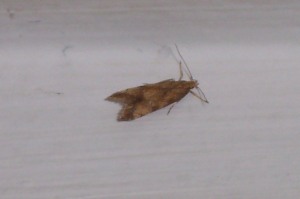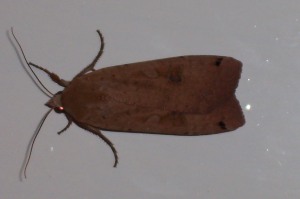In the preceding post I dispensed with the more commonplace and familiar among last night’s visitors. The rest of the motley collection are a vexacious offering – for the most part unnamed. But at least the dreary prose will be leavened with the odd photograph or three.
Before we get to the illustrated part I must mention the Pug. These are small moths and a constant source of frustration. They lurk in high corners often in poor light and they are small. Even when they do hang about until daylight they are not often easy to differentiate. The Pug that was in last night was perhaps this, or perhaps that. The photographs are not a great help except in eliminating a number of the more extravagently marked species of pug. So it remain The Pug.
There were two very small moths and after expending further time this evening attempting to ID or at least even form an idea of which families they belong in I’ve given up. The photographs will not be any assistance, but here, for what it is worth are the next two moths:


On the other hand there was a very familiar figure making a return for the first time this year; vast and vividly orange then strangely subdued once it had settled into its resting position this is the Large Yellow Underwing (noctua pronuba). This is a species that came to the bathroom quite frequently in 2007 but was notably absent last year.

Large Yellow Underwing (noctua pronuba)
With a wing span of around 55mm it is far larger than most of the moths that come to the bathroom. If it is about this year then it could become a frequent visitor between now and October which is its flying season. The larva feed on a wide variety of herbaceous plants.
Having realised that I’ve omitted to mention yet another of the moths that I cannot name and couldn’t photograh I’m left with the final three.
The first is a smallish and very unremarkable moth in that it conforms to the stereotype of being heavy bodies and dingy and furry. That said it is actually quite distinctive in its very unremarkableness (sorry). There have been two of these moths in the house already this year, this photograph taken last night is possibly the best I’ve managed in terms of capturing what defininition of marking it has:

It is about two thirds the size of a Bright-line Brown-eye or slightly larger and the wings have a blunter shape to them.
The last two I have tentatively identified. The first is the kamikaze character that has been bombarding the closed window. It is big, approaching the size of the Large Yellow Underwing but seems bigger because it is quite frenetic around light. Last night there were half a dozen in the room at one point and it was almost too much. My hesitation in naming comes because the ones I’ve had visit have all rested so that some part of the underwing is clearly visible, with wings somewhat spread out, which is not a pose the Broom Moth (melanchra pisi) is normally shown in.

Broom Moth (melanchra pisi)?

Broom moth (melanchra pisi)?
And yes, the last (just before I head up to have a look at what tonight has brought) is I think a Marbled White Spot (protodeltote pygarga). I simply cannot find anything, anywhere that has the same shaped pale patch across the wings.

Marbled White Spot (protodeltote pygarga)?
What a relief. For the record I found my first Garden Carpet moth outside (as opposed to indoors) resting on the trunk of one of the green gage trees. And also for the record the olives are recalcitrant. We had a downpour here today and I haven’t been outside in the garden since. Those buds have to open one day.
